instrument panel LINCOLN NAUTILUS 2020 Owners Manual
[x] Cancel search | Manufacturer: LINCOLN, Model Year: 2020, Model line: NAUTILUS, Model: LINCOLN NAUTILUS 2020Pages: 596, PDF Size: 5.88 MB
Page 4 of 596
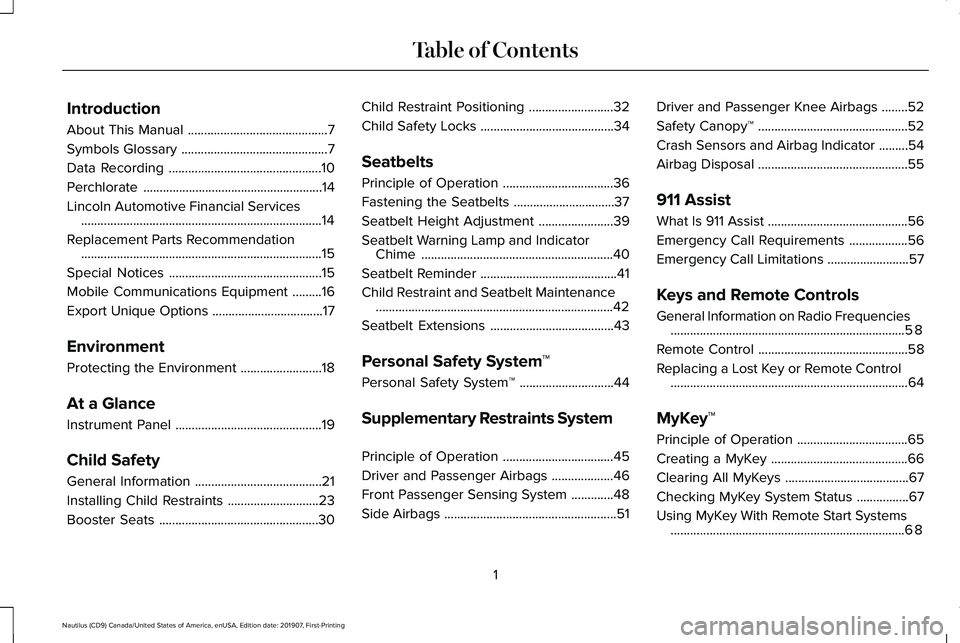
Introduction
About This Manual
...........................................7
Symbols Glossary .............................................
7
Data Recording ...............................................
10
Perchlorate .......................................................
14
Lincoln Automotive Financial Services ........................................................................\
..
14
Replacement Parts Recommendation ........................................................................\
..
15
Special Notices ...............................................
15
Mobile Communications Equipment .........
16
Export Unique Options ..................................
17
Environment
Protecting the Environment .........................
18
At a Glance
Instrument Panel .............................................
19
Child Safety
General Information .......................................
21
Installing Child Restraints ............................
23
Booster Seats .................................................
30Child Restraint Positioning
..........................
32
Child Safety Locks .........................................
34
Seatbelts
Principle of Operation ..................................
36
Fastening the Seatbelts ...............................
37
Seatbelt Height Adjustment .......................
39
Seatbelt Warning Lamp and Indicator Chime ...........................................................
40
Seatbelt Reminder ..........................................
41
Child Restraint and Seatbelt Maintenance ........................................................................\
.
42
Seatbelt Extensions ......................................
43
Personal Safety System ™
Personal Safety System ™.............................
44
Supplementary Restraints System
Principle of Operation ..................................
45
Driver and Passenger Airbags ...................
46
Front Passenger Sensing System .............
48
Side Airbags .....................................................
51Driver and Passenger Knee Airbags
........
52
Safety Canopy™ ..............................................
52
Crash Sensors and Airbag Indicator .........
54
Airbag Disposal ..............................................
55
911 Assist
What Is 911 Assist ...........................................
56
Emergency Call Requirements ..................
56
Emergency Call Limitations .........................
57
Keys and Remote Controls
General Information on Radio Frequencies ........................................................................\
58
Remote Control ..............................................
58
Replacing a Lost Key or Remote Control ........................................................................\
.
64
MyKey™
Principle of Operation ..................................
65
Creating a MyKey ..........................................
66
Clearing All MyKeys ......................................
67
Checking MyKey System Status ................
67
Using MyKey With Remote Start Systems ........................................................................\
68
1
Nautilus (CD9) Canada/United States of America, enUSA, Edition date: 201907, First-Printing Table of Contents
Page 8 of 596
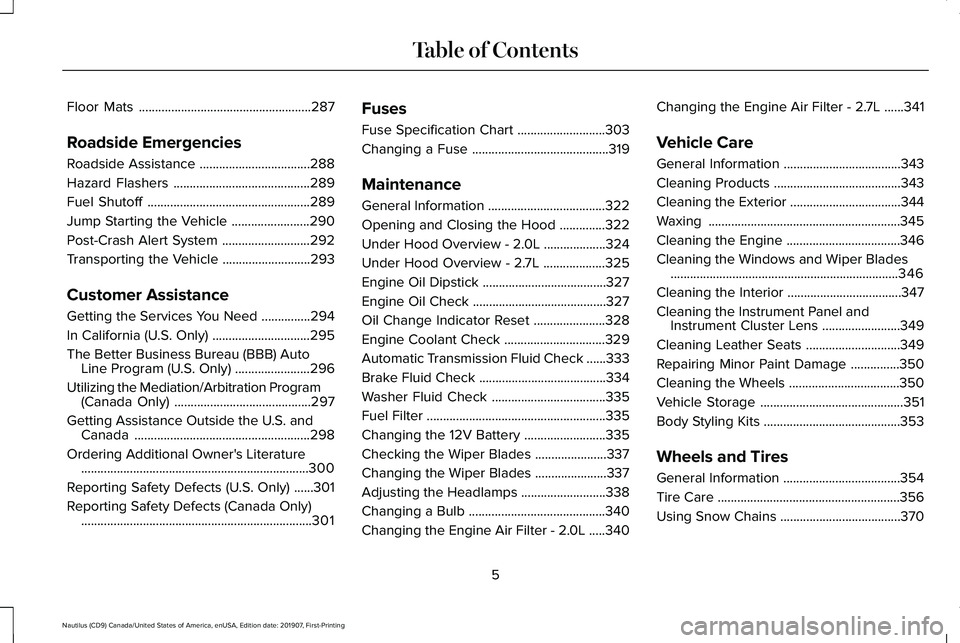
Floor Mats
.....................................................287
Roadside Emergencies
Roadside Assistance ..................................
288
Hazard Flashers ..........................................
289
Fuel Shutoff ..................................................
289
Jump Starting the Vehicle ........................
290
Post-Crash Alert System ...........................
292
Transporting the Vehicle ...........................
293
Customer Assistance
Getting the Services You Need ...............
294
In California (U.S. Only) ..............................
295
The Better Business Bureau (BBB) Auto Line Program (U.S. Only) .......................
296
Utilizing the Mediation/Arbitration Program (Canada Only) ..........................................
297
Getting Assistance Outside the U.S. and Canada ......................................................
298
Ordering Additional Owner's Literature ......................................................................
300
Reporting Safety Defects (U.S. Only) ......
301
Reporting Safety Defects (Canada Only) .......................................................................
301 Fuses
Fuse Specification Chart
...........................
303
Changing a Fuse ..........................................
319
Maintenance
General Information ....................................
322
Opening and Closing the Hood ..............
322
Under Hood Overview - 2.0L ...................
324
Under Hood Overview - 2.7L ...................
325
Engine Oil Dipstick ......................................
327
Engine Oil Check .........................................
327
Oil Change Indicator Reset ......................
328
Engine Coolant Check ...............................
329
Automatic Transmission Fluid Check ......
333
Brake Fluid Check .......................................
334
Washer Fluid Check ...................................
335
Fuel Filter .......................................................
335
Changing the 12V Battery .........................
335
Checking the Wiper Blades ......................
337
Changing the Wiper Blades ......................
337
Adjusting the Headlamps ..........................
338
Changing a Bulb ..........................................
340
Changing the Engine Air Filter - 2.0L .....
340Changing the Engine Air Filter - 2.7L
......
341
Vehicle Care
General Information ....................................
343
Cleaning Products .......................................
343
Cleaning the Exterior ..................................
344
Waxing ...........................................................
345
Cleaning the Engine ...................................
346
Cleaning the Windows and Wiper Blades ......................................................................
346
Cleaning the Interior ...................................
347
Cleaning the Instrument Panel and Instrument Cluster Lens ........................
349
Cleaning Leather Seats .............................
349
Repairing Minor Paint Damage ...............
350
Cleaning the Wheels ..................................
350
Vehicle Storage ............................................
351
Body Styling Kits ..........................................
353
Wheels and Tires
General Information ....................................
354
Tire Care ........................................................
356
Using Snow Chains .....................................
370
5
Nautilus (CD9) Canada/United States of America, enUSA, Edition date: 201907, First-Printing Table of Contents
Page 22 of 596
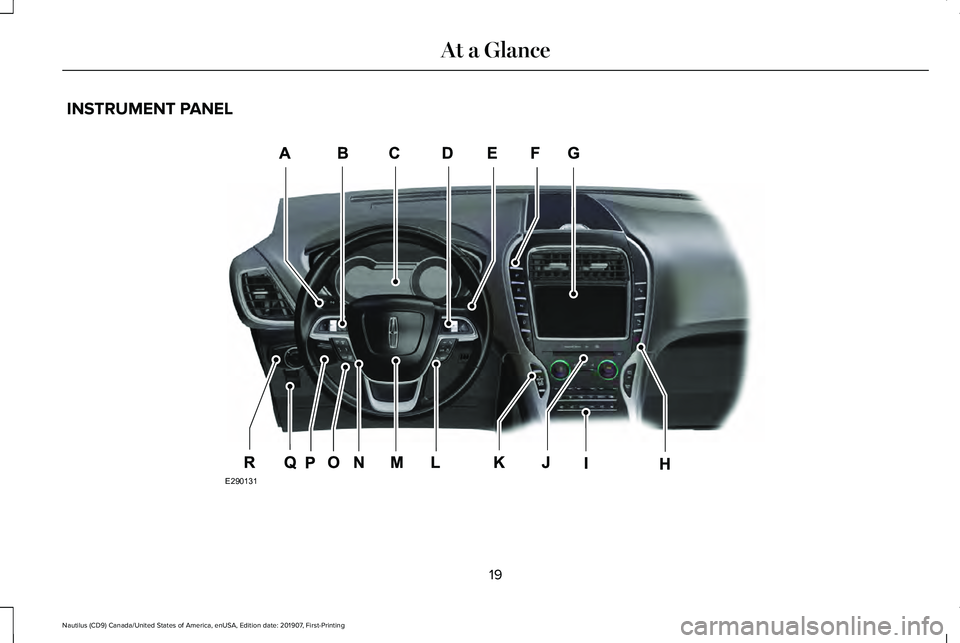
INSTRUMENT PANEL
19
Nautilus (CD9) Canada/United States of America, enUSA, Edition date: 201907, First-Printing At a GlanceE290131
Page 51 of 596
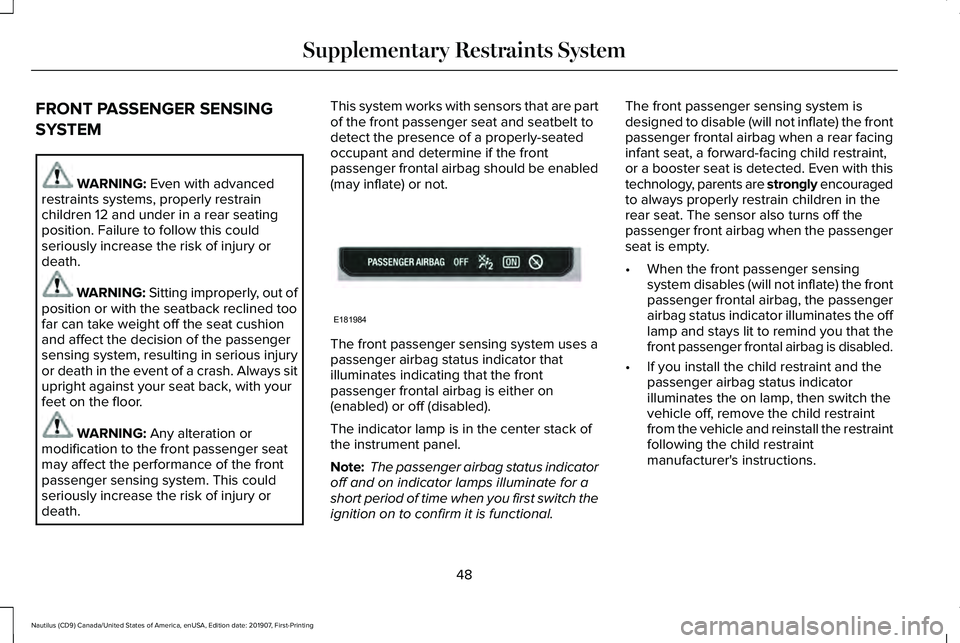
FRONT PASSENGER SENSING
SYSTEM
WARNING: Even with advanced
restraints systems, properly restrain
children 12 and under in a rear seating
position. Failure to follow this could
seriously increase the risk of injury or
death. WARNING:
Sitting improperly, out of
position or with the seatback reclined too
far can take weight off the seat cushion
and affect the decision of the passenger
sensing system, resulting in serious injury
or death in the event of a crash. Always sit
upright against your seat back, with your
feet on the floor. WARNING:
Any alteration or
modification to the front passenger seat
may affect the performance of the front
passenger sensing system. This could
seriously increase the risk of injury or
death. This system works with sensors that are part
of the front passenger seat and seatbelt to
detect the presence of a properly-seated
occupant and determine if the front
passenger frontal airbag should be enabled
(may inflate) or not.
The front passenger sensing system uses a
passenger airbag status indicator that
illuminates indicating that the front
passenger frontal airbag is either on
(enabled) or off (disabled).
The indicator lamp is in the center stack of
the instrument panel.
Note:
The passenger airbag status indicator
off and on indicator lamps illuminate for a
short period of time when you first switch the
ignition on to confirm it is functional. The front passenger sensing system is
designed to disable (will not inflate) the front
passenger frontal airbag when a rear facing
infant seat, a forward-facing child restraint,
or a booster seat is detected. Even with this
technology, parents are strongly encouraged
to always properly restrain children in the
rear seat. The sensor also turns off the
passenger front airbag when the passenger
seat is empty.
•
When the front passenger sensing
system disables (will not inflate) the front
passenger frontal airbag, the passenger
airbag status indicator illuminates the off
lamp and stays lit to remind you that the
front passenger frontal airbag is disabled.
• If you install the child restraint and the
passenger airbag status indicator
illuminates the on lamp, then switch the
vehicle off, remove the child restraint
from the vehicle and reinstall the restraint
following the child restraint
manufacturer's instructions.
48
Nautilus (CD9) Canada/United States of America, enUSA, Edition date: 201907, First-Printing Supplementary Restraints SystemE181984
Page 55 of 596

Crash sensors and monitoring
system with readiness indicator.
See Crash Sensors and Airbag
Indicator (page 54).
The design and development of the side
airbag system included recommended
testing procedures that were developed by
a group of automotive safety experts known
as the Side Airbag Technical Working Group.
These recommended testing procedures
help reduce the risk of injuries related to the
deployment of side airbags.
DRIVER AND PASSENGER KNEE
AIRBAGS WARNING:
To reduce risk of injury,
do not obstruct or place objects in the
deployment path of the airbag. WARNING: Close the glove box door
when your vehicle is moving. Failure to
follow this instruction could reduce the
effectiveness of the passenger knee airbag
and increase the risk of injury in a crash.
A driver knee airbag is located under or
within the instrument panel. A passenger
knee airbag is located within or under the
glove box door. During a crash, the restraints
control module may activate the driver and
passenger knee airbags based on crash
severity and occupant conditions. Under
certain crash and occupant conditions, the
driver and passenger knee airbag may
deploy but the driver front airbag may not
activate. As with front and side airbags, it is
important to be properly seated and
restrained to reduce the risk of death or
serious injury. Make sure the knee airbags are
operating properly.
See Crash
Sensors and Airbag Indicator
(page
54). SAFETY CANOPY™ WARNING:
Do not place objects or
mount equipment on or near the headliner
at the siderail that may come into contact
with a deploying curtain airbag. Failure to
follow these instructions may increase the
risk of personal injury in the event of a
crash. WARNING:
Do not lean your head
on the door. The curtain airbag could injure
you as it deploys from the headliner. WARNING: Do not attempt to service,
repair, or modify the supplementary
restraint system or associated components.
Failure to follow this instruction could result
in personal injury or death.
52
Nautilus (CD9) Canada/United States of America, enUSA, Edition date: 201907, First-Printing Supplementary Restraints SystemE67017 E67017
Page 82 of 596

Opening and Closing the Liftgate
WARNING: Make sure all persons
are clear of the power liftgate area before
using the power liftgate control.
Note: Make sure the area behind your
vehicle is free from obstruction and that
there is enough room for you to operate the
liftgate. Objects too close to your vehicle, for
example a wall, garage door or another
vehicle may come into contact with the
moving liftgate. This could damage the
liftgate and its components.
Note: Be careful when opening or closing
the liftgate in a garage or other enclosed
area to avoid damaging the liftgate.
Note: Do not leave the liftgate open while
driving. This could damage the liftgate and
its components.
From the Instrument Panel With the transmission in park (P),
press the button on the instrument
panel. Remote Control Press the button twice within three
seconds.
Outside Control Button
Opening the Liftgate
1. Unlock the liftgate with the remote control or power door unlock control. If
a passive key is within
3 ft (1 m) of the
liftgate, the liftgate unlocks when you
press the liftgate release button. 2. Press the liftgate release button.
79
Nautilus (CD9) Canada/United States of America, enUSA, Edition date: 201907, First-Printing LiftgateE138633 E138630 E201985
2
Page 83 of 596
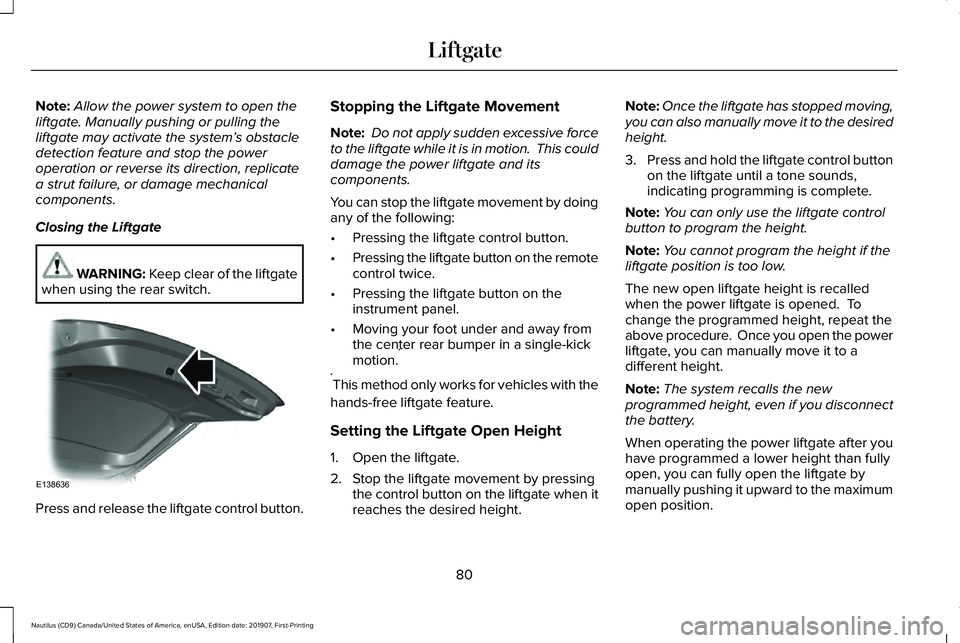
Note:
Allow the power system to open the
liftgate. Manually pushing or pulling the
liftgate may activate the system’ s obstacle
detection feature and stop the power
operation or reverse its direction, replicate
a strut failure, or damage mechanical
components.
Closing the Liftgate WARNING: Keep clear of the liftgate
when using the rear switch. Press and release the liftgate control button. Stopping the Liftgate Movement
Note:
Do not apply sudden excessive force
to the liftgate while it is in motion. This could
damage the power liftgate and its
components.
You can stop the liftgate movement by doing
any of the following:
• Pressing the liftgate control button.
• Pressing the liftgate button on the remote
control twice.
• Pressing the liftgate button on the
instrument panel.
• Moving your foot under and away from
the center rear bumper in a single-kick
motion. *
* This method only works for vehicles with the
hands-free liftgate feature.
Setting the Liftgate Open Height
1. Open the liftgate.
2. Stop the liftgate movement by pressing the control button on the liftgate when it
reaches the desired height. Note:
Once the liftgate has stopped moving,
you can also manually move it to the desired
height.
3. Press and hold the liftgate control button
on the liftgate until a tone sounds,
indicating programming is complete.
Note: You can only use the liftgate control
button to program the height.
Note: You cannot program the height if the
liftgate position is too low.
The new open liftgate height is recalled
when the power liftgate is opened. To
change the programmed height, repeat the
above procedure. Once you open the power
liftgate, you can manually move it to a
different height.
Note: The system recalls the new
programmed height, even if you disconnect
the battery.
When operating the power liftgate after you
have programmed a lower height than fully
open, you can fully open the liftgate by
manually pushing it upward to the maximum
open position.
80
Nautilus (CD9) Canada/United States of America, enUSA, Edition date: 201907, First-Printing LiftgateE138636
Page 97 of 596
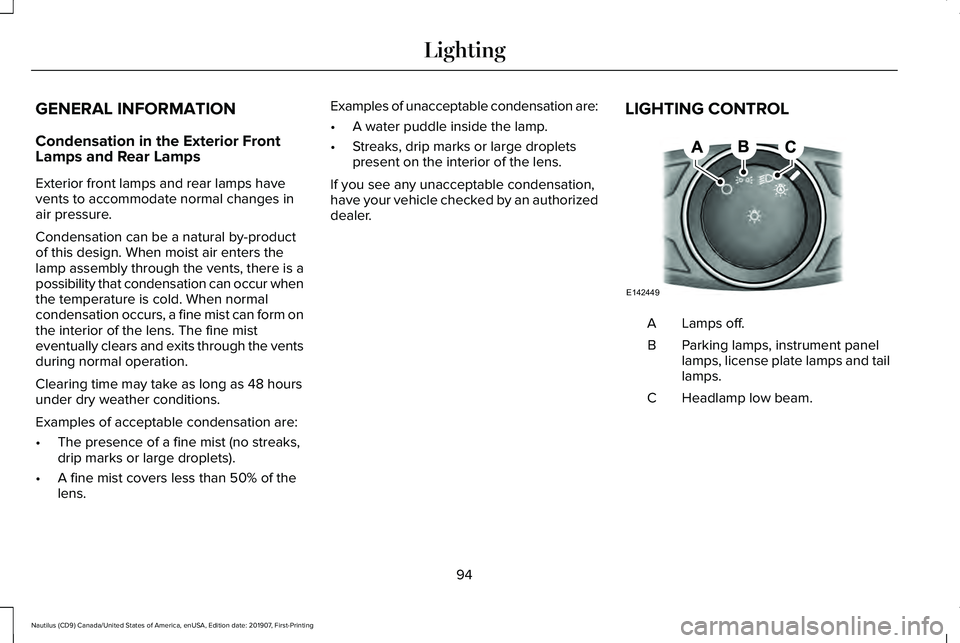
GENERAL INFORMATION
Condensation in the Exterior Front
Lamps and Rear Lamps
Exterior front lamps and rear lamps have
vents to accommodate normal changes in
air pressure.
Condensation can be a natural by-product
of this design. When moist air enters the
lamp assembly through the vents, there is a
possibility that condensation can occur when
the temperature is cold. When normal
condensation occurs, a fine mist can form on
the interior of the lens. The fine mist
eventually clears and exits through the vents
during normal operation.
Clearing time may take as long as 48 hours
under dry weather conditions.
Examples of acceptable condensation are:
•
The presence of a fine mist (no streaks,
drip marks or large droplets).
• A fine mist covers less than 50% of the
lens. Examples of unacceptable condensation are:
•
A water puddle inside the lamp.
• Streaks, drip marks or large droplets
present on the interior of the lens.
If you see any unacceptable condensation,
have your vehicle checked by an authorized
dealer. LIGHTING CONTROL Lamps off.
A
Parking lamps, instrument panel
lamps, license plate lamps and tail
lamps.
B
Headlamp low beam.
C
94
Nautilus (CD9) Canada/United States of America, enUSA, Edition date: 201907, First-Printing LightingE142449
Page 146 of 596
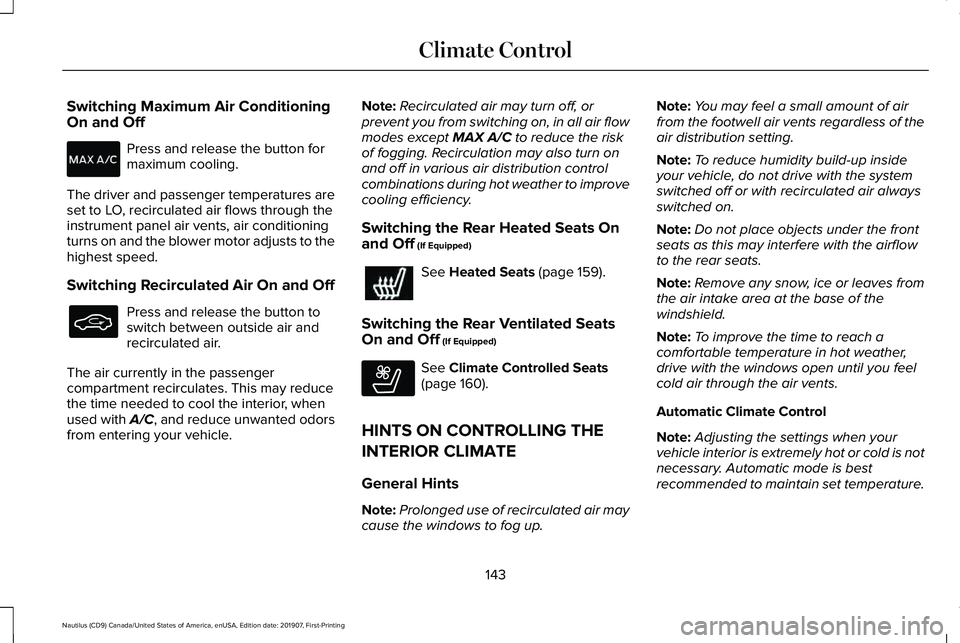
Switching Maximum Air Conditioning
On and Off
Press and release the button for
maximum cooling.
The driver and passenger temperatures are
set to LO, recirculated air flows through the
instrument panel air vents, air conditioning
turns on and the blower motor adjusts to the
highest speed.
Switching Recirculated Air On and Off Press and release the button to
switch between outside air and
recirculated air.
The air currently in the passenger
compartment recirculates. This may reduce
the time needed to cool the interior, when
used with A/C, and reduce unwanted odors
from entering your vehicle. Note:
Recirculated air may turn off, or
prevent you from switching on, in all air flow
modes except MAX A/C to reduce the risk
of fogging. Recirculation may also turn on
and off in various air distribution control
combinations during hot weather to improve
cooling efficiency.
Switching the Rear Heated Seats On
and Off
(If Equipped) See
Heated Seats (page 159).
Switching the Rear Ventilated Seats
On and Off
(If Equipped) See
Climate Controlled Seats
(page 160).
HINTS ON CONTROLLING THE
INTERIOR CLIMATE
General Hints
Note: Prolonged use of recirculated air may
cause the windows to fog up. Note:
You may feel a small amount of air
from the footwell air vents regardless of the
air distribution setting.
Note: To reduce humidity build-up inside
your vehicle, do not drive with the system
switched off or with recirculated air always
switched on.
Note: Do not place objects under the front
seats as this may interfere with the airflow
to the rear seats.
Note: Remove any snow, ice or leaves from
the air intake area at the base of the
windshield.
Note: To improve the time to reach a
comfortable temperature in hot weather,
drive with the windows open until you feel
cold air through the air vents.
Automatic Climate Control
Note: Adjusting the settings when your
vehicle interior is extremely hot or cold is not
necessary. Automatic mode is best
recommended to maintain set temperature.
143
Nautilus (CD9) Canada/United States of America, enUSA, Edition date: 201907, First-Printing Climate Control E268558
Page 147 of 596

Note:
The system adjusts to heat or cool the
interior to the temperature you select as
quickly as possible.
Note: For the system to function efficiently,
the instrument panel and side air vents
should be fully open.
Note: If you select AUTO during cold outside
temperatures, the system directs air flow to
the windshield and side window air vents. In
addition, the blower motor may run at a
slower speed until the engine warms up.
Note: If you select
AUTO during hot
temperatures and the inside of the vehicle
is hot, the system uses recirculated air to
maximize interior cooling. Blower motor
speed may also reduce until the air cools.
Quickly Heating the Interior
1. Press and release
AUTO.
2. Adjust the temperature function to the setting you prefer.
Recommended Settings for Heating
1. Press and release
AUTO. 2. Adjust the temperature function to the
setting you prefer. Use
72°F (22°C) as a
starting point, then adjust the setting as
necessary.
Quickly Cooling the Interior
1. Press and release
MAX A/C.
Recommended Settings for Cooling
1. Press and release
AUTO.
2. Adjust the temperature function to the setting you prefer. Use
72°F (22°C) as a
starting point, then adjust the setting as
necessary.
Defogging the Side Windows in Cold
Weather
1. Press and release defrost.
2. Adjust the temperature control to the setting you prefer. Use
72°F (22°C) as a
starting point, then adjust the setting as
necessary. HEATED WINDSHIELD
(IF EQUIPPED)
Windshield Wiper De-Icer When you switch the heated rear
window on, the windshield wiper
de-icer turns on.
HEATED REAR WINDOW Press the button to clear the rear
window of thin ice and fog. The
heated rear window turns off after
a short period of time.
Note: Do not use harsh chemicals, razor
blades or other sharp objects to clean or
remove decals from the inside of the heated
rear window. The vehicle warranty may not
cover damage to the heated rear window
grid lines.
HEATED EXTERIOR MIRRORS
When you switch the heated rear window
on, the heated exterior mirrors turn on.
144
Nautilus (CD9) Canada/United States of America, enUSA, Edition date: 201907, First-Printing Climate ControlE184884 E184884